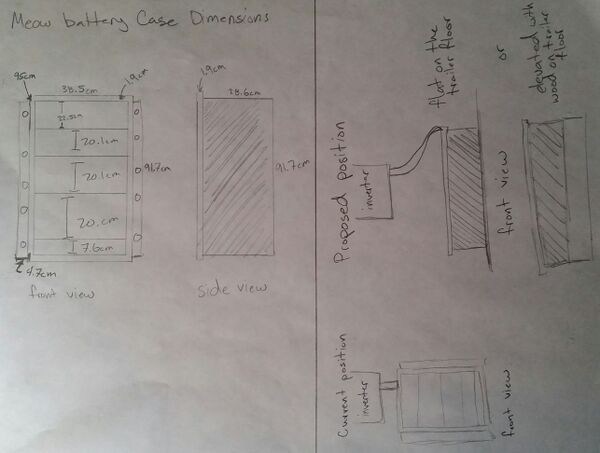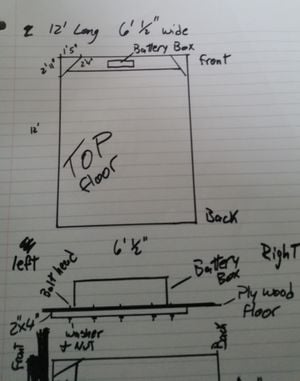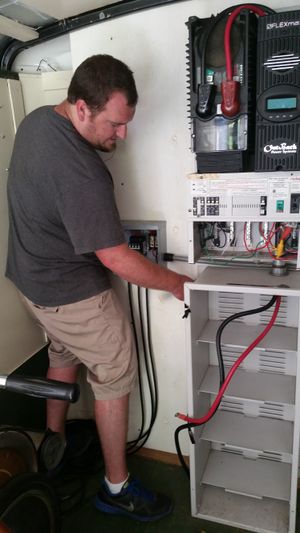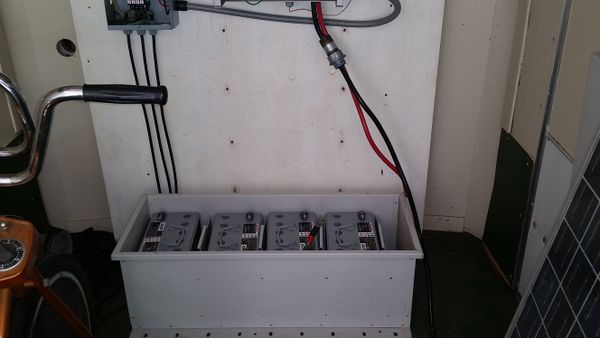| Line 9: | Line 9: | ||
[[File:20150129 142150.jpg|thumb|left|upright=2| This is the interior of MEOW as of January 29th 2015 with the bikes and solar panels.]] | [[File:20150129 142150.jpg|thumb|left|upright=2| This is the interior of MEOW as of January 29th 2015 with the bikes and solar panels.]] | ||
[[File:20150129 142201.jpg|thumb|right|upright=2| This is the MEOW's electronic system and battery case in the upright position.]] | [[File:20150129 142201.jpg|thumb|right|upright=2| This is the MEOW's electronic system and battery case in the upright position.]] | ||
The Mobile Energy Operation Wagon or [[MEOW]] is a trailer that has mounted solar panels that generate renewable energy and stores that energy in batteries. The MEOW is currently located on the Humboldt State University campus at the Campus Center for Appropriate Technology or [[CCAT]]. The MEOW was constructed in 2003 to be transportable renewable energy source for a variety of events <ref name="Wagon Stolen">http://www.times-standard.com/20110125/ccat-recovers-mobile-energy-wagon-board-meets-to-discuss-future-of-meow-after-it-was-stolen-vandalized-last-month </ref>. Sadly in 2010 the MEOW was stolen and stripped of all valuable materials and the solar mounting rack built in May of 2005 was ruined <ref name="Solar Rack"> http://www.appropedia.org/CCAT_MEOW_rack </ref> <ref name="Wagon Stolen"/>. Fortunately, funding was able to be gathered to help bring the MEOW back on its paws! In May 2012, a new mounting rack for the solar panels was constructed and attached to the MEOW<ref name="MEOW">http://www.appropedia.org/CCAT_MEOW </ref>. In November of 2012, a group students rejuvenated the MEOW’s solar energy system <ref name="MEOW"/>. | The Mobile Energy Operation Wagon or [[MEOW]] is a trailer that has mounted solar panels that generate renewable energy and stores that energy in batteries. The MEOW is currently located on the Humboldt State University campus at the Campus Center for Appropriate Technology or [[CCAT]]. The MEOW was constructed in 2003 to be transportable renewable energy source for a variety of events, specially CCAT May Day festivities <ref name="Wagon Stolen">http://www.times-standard.com/20110125/ccat-recovers-mobile-energy-wagon-board-meets-to-discuss-future-of-meow-after-it-was-stolen-vandalized-last-month </ref>. Sadly in 2010 the MEOW was stolen and stripped of all valuable materials and the solar mounting rack built in May of 2005 was ruined <ref name="Solar Rack"> http://www.appropedia.org/CCAT_MEOW_rack </ref> <ref name="Wagon Stolen"/>. Fortunately, funding was able to be gathered to help bring the MEOW back on its paws! In May 2012, a new mounting rack for the solar panels was constructed and attached to the MEOW<ref name="MEOW">http://www.appropedia.org/CCAT_MEOW </ref>. In November of 2012, a group students rejuvenated the MEOW’s solar energy system <ref name="MEOW"/>. | ||
Revision as of 23:33, 26 April 2015
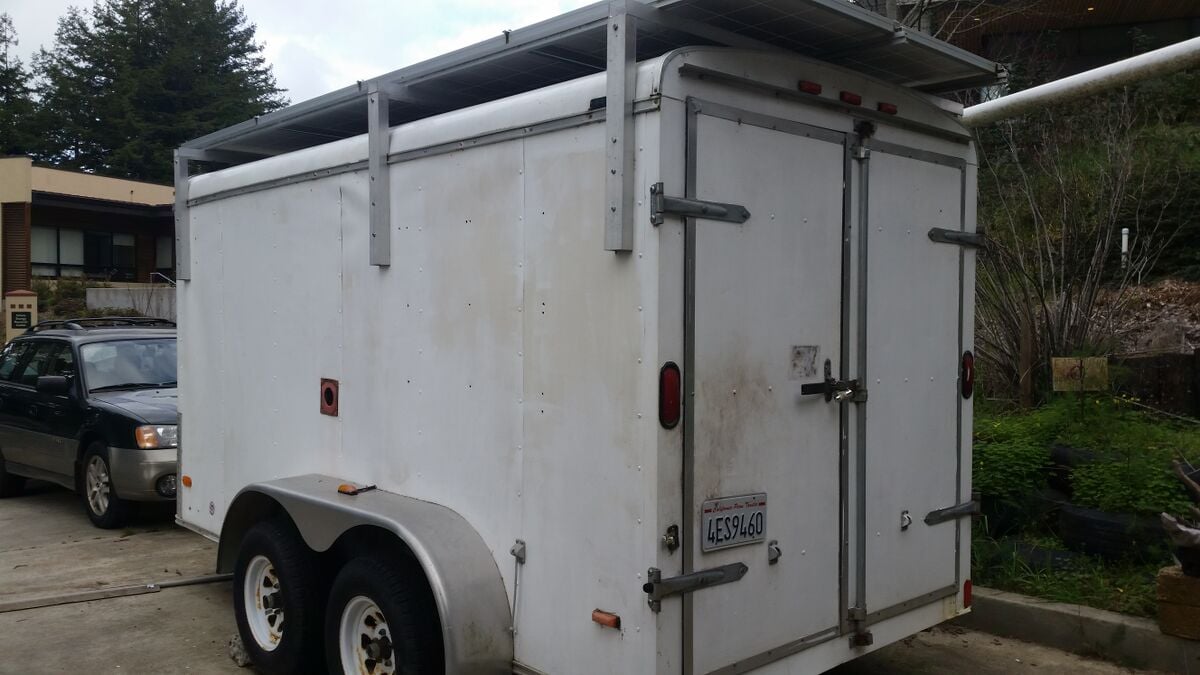
Abstract
The following project describes changes made by students from ENGR 305 on the Mobile Energy Operation Wagon (MEOW) during the spring of 2015. These changes consisted in design a battery case to the new batteries, aiming to prolong the life of the new batteries and reestablish the MEOW to working order.
(The Mobile Energy Operation Wagon needed new batteries and a change in the position of the battery case. This was a project conducted in the spring of 2015 to prolong the the life of the new batteries and reestablish the MEOW to working order.)
Background

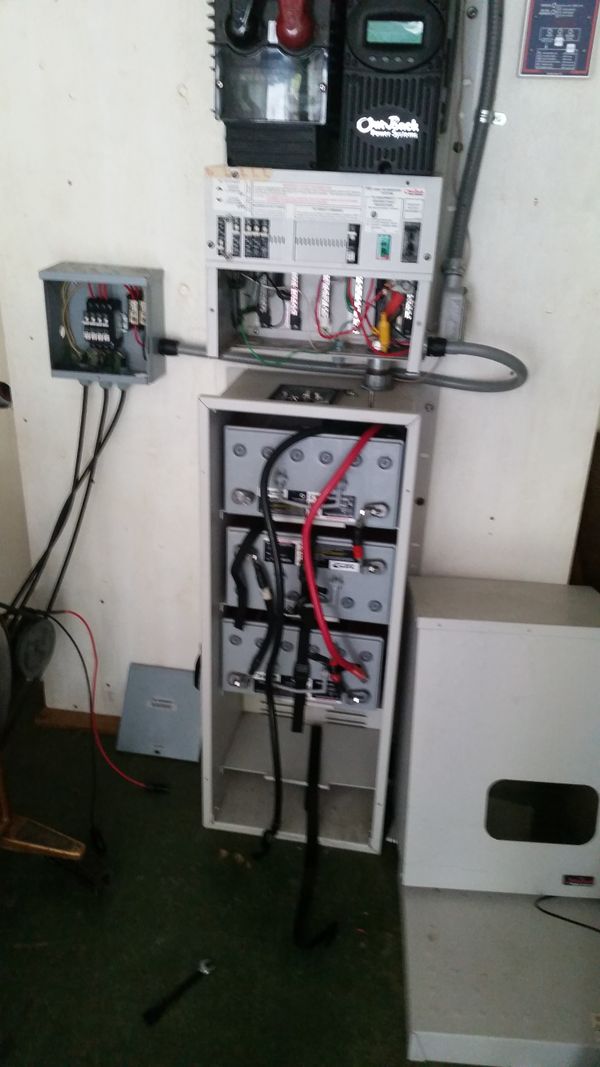
The Mobile Energy Operation Wagon or MEOW is a trailer that has mounted solar panels that generate renewable energy and stores that energy in batteries. The MEOW is currently located on the Humboldt State University campus at the Campus Center for Appropriate Technology or CCAT. The MEOW was constructed in 2003 to be transportable renewable energy source for a variety of events, specially CCAT May Day festivities [1]. Sadly in 2010 the MEOW was stolen and stripped of all valuable materials and the solar mounting rack built in May of 2005 was ruined [2] [1]. Fortunately, funding was able to be gathered to help bring the MEOW back on its paws! In May 2012, a new mounting rack for the solar panels was constructed and attached to the MEOW[3]. In November of 2012, a group students rejuvenated the MEOW’s solar energy system [3].
Three Humboldt State University students, Destinee McGuire, John Cylwik, and Wilson Franca de Souza, are tasked with the job of repairing the charging system and the batteries on the MEOW. There is a visible issue with the batteries housing units which appear to be bulging. Since the batteries contain hazardous chemicals, there is a possibility of damaging the environment, humans, and the MEOW. The first goal of our project is to see what is causing the batteries to expand in their housing units and properly dispose of the old batteries. Then, if we discover the problems and buy new batteries, we will continue to work on the MEOW's system. Our project is going to be from January 26 2015 to about Mid-May 2015. We will be working at CCAT where the MEOW is located.

Problem statement
The objective of this project is to restore the Mobile Energy Operation Wagon (MEOW) to working condition by assessing the problems with the solar system and changing the battery case position to retain battery lifespan.
Criteria
| Criteria | Constraints | Weight (0-10) |
|---|---|---|
| Safety | safe for people to be close to batteries without possibility of shock | 10 |
| Ease of Use | 10th grade and up education could understand how to use the MEOW | 9 |
| Effectiveness | produces power (more is good) | 6 |
| Maintainability | MEOW can be restored, if not functioning, in less than 7 days | 8 |
| Educational Value | easier the explanation for how the MEOW works | 7 |
| Insulation | keep MEOW batteries between optimal temperatures to prolong battery life | 5 |
| Cost | Within given budget | 7 |
Timeline
| Objectives | Relative Week |
|---|---|
| Pending groups | Week 1 Jan 19th |
| Group meeting | Week 2 Jan 26th |
| Gather background on MEOW/Research on solar power | Week 3 Feb 2nd |
| Go to MEOW and access batteries | Week 4 Feb 9th |
| Take batteries to check voltage at NAPA | Week 5 Feb 16th |
| Creating Budget/approval | Week 6 Feb 23rd |
| Research battery types and Look at battery housing | Week 7 Mar 3rd |
| Negotiate battery type and start the approval process | Week 8 Mar 9th |
| Recalibrate equipment to test old batteries in system (if Sun available) | Week 10 Mar 23rd |
| Research more about MEOW’s current system (no schematic found) | Week 11 Mar 30th |
| Pull battery case down and determine EQ setting not on | Week 12 Apr 6th |
| Attach battery case in the laying down position | Week 13 Apr 13th |
| Attach new batteries and test system if available sun | Week 14 Apr 20th |
| Prepare for festival | Week 15 Apr 27 |
| Report turned in and Appropedia page completed | Week 16 May 4th |
Costs
This was the costs associated with moving the battery case and purchasing new batteries for the MEOW. Funding for new batteries was from CCAT.
| Quantity | Material | Source | Cost ($) | Total ($) |
|---|---|---|---|---|
| 4 | 12V 115ah AGN SLA batteries | Redding Vender | 235.00 | 940.00 |
| 1 | 2x4x8 plank | The Mill Yard | 2.93 | 2.93 |
| 1 | Lock Nut Pack(19) | The Mill Yard | 1.90 | 1.90 |
| 1 | Zinc 5/16-18x3-1/2 Hex Bolt Pack (29) | The Mill Yard | 2.90 | 2.90 |
| 1 | Zinc 5/16 Flat Washer Pack (9) | The Mill Yard | 0.90 | 0.90 |
| Total Cost | $948.63 | |||
Construction
Operation
The MEOW has another Appropedia page dedicated to care and use of the MEOW. This page can be accessed here CCAT MEOW/OM. Previously, the page had included the information of equalizing the batteries. This is not recommended for sealed batteries, as indicated in the user manual of the solar system, and this could drastically shorten the lifespan of the batteries. To prevent the EQ setting, do not access the setting. The default system set up is without a EQ phase in the charging of the batteries.
Conclusion
The battery case position change was not difficult to accomplish. The most challenging aspect was getting the authorization to drill into the MEOW. The construction was smooth except for the loss of a 1/2 inch socket which caused John to use a 1/2 inch wrench to tighten the bolts down. The socket was found after the construction was completed. Research for new batteries was conducted to aid in the help of ordering new batteries. This process was hard to deal with because the communication chain took a while. The batteries purchased were not any of the specific brands researched but CCAT was able to negotiate a deal for the price. The best price they could find with the specification the MEOW needed. Hopefully we are able to have the MOEW in working condition for the May Day Festival on May 2nd. (will post picture of the festival and write more once event has happened)
Literature Review
In nickel metal hydride (NMH) batteries some charging energy is converted into heat and used to expand gases. The batteries in the study made sure that after the batteries had a full charge, the input would be cut off. Overcharging can cause problems and should be eliminated. The system in the book was a mobile unit that was used to broadcast radio. [4]
"Deployment of renewable energy sources can be a key feature of regional development and assists in achieving greater social and economic cohesion within a country. Grid extension, noise and pollution are avoided in PV projects. In both centralised and decentralised systems, adverse visual impact is also avoidable with sensitive design."
[5]
The article reports that solar developers and contractors are gearing up for new sector growth as more U.S. states allow direct sale of solar power to electricity customers. It reveals that utilities and regional firms are eyeing on smaller but mass-volume rooftop solar installations for residential, commercial, industrial and institutional buildings. The opportunities for growth in the residential market are highlighted.[6]
“With the several types of energy storage systems and the range of requirements for the various services categories, it can be difficult to determine the suitability of a system for a given application. Discharge time of a system is one characteristic that can immediately identify possible options for a given application. By comparing the stored energy quantity and power requirements of the application with the characteristics of the battery technologies, one or more suitable types may be identified. Following this process, battery technologies can be compared on other merits such as cycle life, cost, and efficiency.”[7]
“Photovoltaic solar energy is one of the most widely used renewable energy. A key component in photovoltaic generation systems is the DC-AC converter [1,2]. In these applications multilevel inverters are usually used. These can give an AC voltage from several DC sources, that is, from the photovoltaic generators. Multilevel inverters have lower output harmonic content monolevel inverters.”[8]
“There is more to comparing batteries than just cost or amp-hour ratings. For example, based only on cost, the Concorde AGM's do not look so good. On the other hand, you probably would not want to store a flooded battery in your computer room. There is no one best battery for all applications. If the batteries are in a remote communications site, low maintenance might be the most important feature. For the off-grid full time home, capacity. life, and long term cost would probably be the most important.”[9]
Biking is the most energy-efficient way to travel compared to animals and machines. During the Race Across America, the average efficiency was about 20% which is fantastic and in no reach of fossil fuel cars.
374 calories are required to produce 100 W per hour and the average person can produce about 0.75 W for several hours and 225 W when pressing hard for a few minutes. A physically fit cyclist can produce 375 W for a few minutes and 525 W for up to a minute.[10]
In Medford Oregon, the average yearly insolation availability in kWH/m^2 for a fixed panel with a latitude tilt of -15 degree is 4.88. This is the closest latitudinal location to Arcata California. For a tracking array, the available insolation averages 6.5 kWH/m^2. Knowing the solar insolation is very helping in determining the solar panel systems potential throughout the year.
Inverters are an important aspect to an electrical system because it dictates the wave output (square, modified sine, or sine) and affects the efficiency.[11]
“The warm season lasts from June 24 to October 13 with an average daily high temperature above 62°F. The hottest day of the year is September 2, with an average high of 64°F and low of 50°F.”[12]
“The cold season lasts from November 26 to April 14 with an average daily high temperature below 56°F. The coldest day of the year is December 23, with an average low of 39°F and high of 54°F.”[12]
“The length of the day varies significantly over the course of the year. The shortest day is December 21 with 9:14 hours of daylight; the longest day is June 20 with 15:09 hours of daylight.”[12]
“The earliest sunrise is at 5:43am on June 11 and the latest sunset is at 8:53pm on June 29. The latest sunrise is at 7:51am on November 3 and the earliest sunset is at 4:48pm on December 9.”[12]
“Daylight savings time (DST) is observed in this location during 2012, starting in the spring on March 11 and ending in the fall on November 4.”[12]
“The median cloud cover ranges from 83% (mostly cloudy) to 95% (overcast). The sky is cloudiest on March 9 and clearest on September 16. The clearer part of the year begins around May 18. The cloudier part of the year begins around November 13.”[12]
“On September 16, the clearest day of the year, the sky is clear, mostly clear, or partly cloudy 42% of the time, and overcast or mostly cloudy 58% of the time.”[12]
“On March 9, the cloudiest day of the year, the sky is overcast, mostly cloudy, or partly cloudy 76% of the time, and clear or mostly clear 24% of the time.”[12]
“The probability that precipitation will be observed at this location varies throughout the year. Precipitation is most likely around March 12, occurring in 56% of days. Precipitation is least likely around August 8, occurring in 11% of days.”[12]
“Over the entire year, the most common forms of precipitation are light rain, moderate rain, and drizzle.”[12]
“Light rain is the most severe precipitation observed during 49% of those days with precipitation. It is most likely around February 21, when it is observed during 29% of all days.”[12]
“Moderate rain is the most severe precipitation observed during 28% of those days with precipitation. It is most likely around December 16, when it is observed during 19% of all days.”[12]
“Drizzle is the most severe precipitation observed during 11% of those days with precipitation. It is most likely around June 30, when it is observed during 7% of all days.”[12]
Rechargeable batteries sales throughout the world included Nickel-cadmium, Nickel metal hydride, and lithium-ion batteries from 1986 to 2005. Lithium-ion batteries were the largest part of the sales in 2005. the cadmium batteries are still used but in fewer quantity because of the possible heavy metal exposure. For cadmium batteries, an estimated lifespan of 15 years for industrial batteries, 6 years for electric vehicle batteries, and 3 years for consumer batteries.[13]
References
Team
- Destinee McGuire
- John Cylwik
- Wilson Franca de Souza
- ↑ 1.0 1.1 http://www.times-standard.com/20110125/ccat-recovers-mobile-energy-wagon-board-meets-to-discuss-future-of-meow-after-it-was-stolen-vandalized-last-month
- ↑ http://www.appropedia.org/CCAT_MEOW_rack
- ↑ 3.0 3.1 http://www.appropedia.org/CCAT_MEOW
- ↑ Abdurakhmanov, K. P., O. Ochilov, and A. G. Strizhevskii. 2008. Solar photovoltaic battery charger for mobile radio stations.Applied Solar Energy 44, (4) (12): 249-255, http://ezproxy.humboldt.edu/login?url=http://search.proquest.com/docview/231325042?accountid=11532 (accessed February 4, 2015). />
- ↑ Archer, Mary D., and Hill, Robert, eds. Clean Electricity from Photovoltaics. London, GBR: Imperial College Press, 2001. ProQuest ebrary. Web. 8 February 2015. Copyright © 2001. Imperial College Press. All rights reserved. <http://site.ebrary.com/lib/hsulib/reader.action?docID=10255424>/>
- ↑ Carr, Housley. "Rooftop Solar Set To Soar." Engineering News-Record, October 2, 2013, 8. />
- ↑ Leadbetter, Jason, and Lukas G. Swan. "Selection of Battery Technology to Support Grid-integrated Renewable Electricity." Journal of Power Sources 216 (2012): 376-86. http://www.sciencedirect.com/science/article/pii/S0378775312009500/>
- ↑ Reinoso, C.r. Sanchez, M. De Paula, D.h. Milone, and R.h. Buitrago. "Photovoltaic Inverters Optimisation." Energy Procedia 14:1484-489. Accessed February 4, 2015. http://www.sciencedirect.com/science/article/pii/S1876610211045413#. />
- ↑ "Northern Arizona Wind & Sun." Deep Cycle Battery Types Comparisons. http://www.solar-electric.com/deep-cycle-battery-types-comparisons.html./>
- ↑ Perry, David. 1995. Bike Cult : The Ultimate Guide to Human-powered Vehicles. New York: Four Walls Eight Windows./>
- ↑ Stand-Alone Photovoltaic Systems: A Handbook of Recommended Practices. Las Cruces: Photovoltaic Design Assistance Center Sandia National Laboratories, 1995./>
- ↑ 12.00 12.01 12.02 12.03 12.04 12.05 12.06 12.07 12.08 12.09 12.10 12.11 12.12 "WeatherSpark Beta." Average Weather For Arcata, California, USA. https://weatherspark.com/averages/29570/Arcata-California-United-States./>
- ↑ Wilburn, D2007. Flow of Cadmium from Rechargeable Batteries in the United States, 1996-2005. Reston, Va.: U.S. Department of the Interior, U.S. Geological Survey./>
